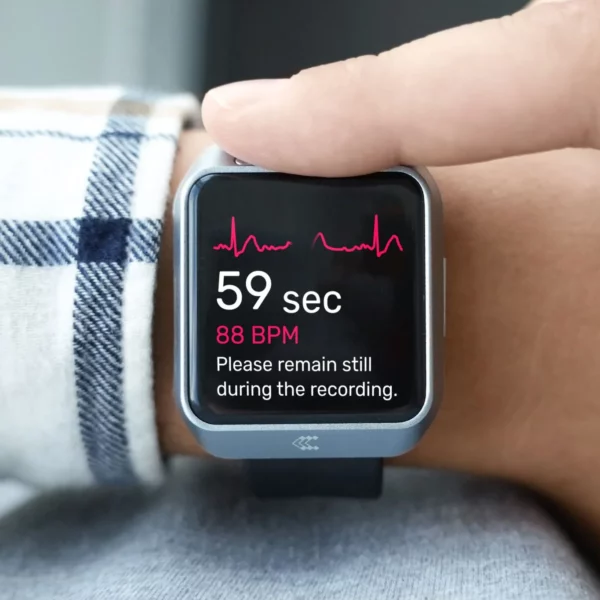Six-Lead Electrocardiography Compared to Single-Lead Electrocardiography and Photoplethysmography of a Wrist-Worn Device for Atrial Fibrillation Detection Controlled by Premature Atrial or Ventricular Contractions: Six Is Smarter Than One

Authors
- Justinas Bacevicius
- Neringa Taparauskaite
- Ricardas Kundelis
- Daivaras Sokas
- Monika Butkuviene
- Guoste Stankeviciute
- Zygimantas Abramikas
- Aiste Pilkiene
- Ernestas Dvinelis
- Justina Staigyte
- Julija Marinskiene
- Deimile Audzijoniene
- Marija Petrylaite
- Edvardas Jukna
- Albinas Karuzas
- Vytautas Juknevicius
- Rusne Jakaite
- Viktorija Basyte-Bacevice
- Neringa Bileisiene
- Ignas Badaras
- Margarita Kiseliute
- Gintare Zarembaite
- Modestas Gudauskas
- Eugenijus Jasiunas
- Linda Johnson
- Vaidotas Marozas
- Audrius Aidietis
Author Affiliations
- Institute of Clinical Medicine, Faculty of Medicine, Vilnius University, Vilnius, Lithuania
- Center of Cardiology and Angiology, Vilnius University Hospital Santaros Klinikos, Vilnius, Lithuania
- Biomedical Engineering Institute, Kaunas University of Technology, Kaunas, Lithuania
- Center of Informatics and Development, Vilnius University Hospital Santaros Klinikos, Vilnius, Lithuania
- Department of Clinical Sciences, Malmö, Lund University, Lund, Sweden
- Electronics Engineering Department, Kaunas University of Technology, Kaunas, Lithuania
Background: Smartwatches are commonly capable to record a lead-I-like electrocardiogram (ECG) and perform a photoplethysmography (PPG)-based atrial fibrillation (AF) detection. Wearable technologies repeatedly face the challenge of frequent premature beats, particularly in target populations for screening of AF.
Objective: To investigate the potential diagnostic benefit of six-lead ECG compared to single-lead ECG and PPG-based algorithm for AF detection of the wrist-worn device.
Methods and results: From the database of DoubleCheck-AF 249 adults were enrolled in AF group (n = 121) or control group of SR with frequent premature ventricular (PVCs) or atrial (PACs) contractions (n = 128). Cardiac rhythm was monitored using a wrist-worn device capable of recording continuous PPG and simultaneous intermittent six-lead standard-limb-like ECG. To display a single-lead ECG, the six-lead ECGs were trimmed to lead-I-like ECGs. Two diagnosis-blinded cardiologists evaluated reference, six-lead and single-lead ECGs as “AF”, “SR”, or “Cannot be concluded”. AF detection based on six-lead ECG, single-lead ECG, and PPG yielded a sensitivity of 99.2%, 95.7%, and 94.2%, respectively. The higher number of premature beats per minute was associated with false positive outcomes of single-lead ECG (18.80 vs. 5.40 beats/min, P < 0.01), six-lead ECG (64.3 vs. 5.8 beats/min, P = 0.018), and PPG-based detector (13.20 vs. 5.60 beats/min, P = 0.05). Single-lead ECG required 3.4 times fewer extrasystoles than six-lead ECG to result in a false positive outcome. In a control subgroup of PACs, the specificity of six-lead ECG, single-lead ECG, and PPG dropped to 95%, 83.8%, and 90%, respectively. The diagnostic value of single-lead ECG (AUC 0.898) was inferior to six-lead ECG (AUC 0.971) and PPG-based detector (AUC 0.921). In a control subgroup of PVCs, the specificity of six-lead ECG, single-lead ECG, and PPG was 100%, 96.4%, and 96.6%, respectively. The diagnostic value of single-lead ECG (AUC 0.961) was inferior to six-lead ECG (AUC 0.996) and non-inferior to PPG-based detector (AUC 0.954).
Conclusions: A six-lead wearable-recorded ECG demonstrated the superior diagnostic value of AF detection compared to a single-lead ECG and PPG-based AF detection. The risk of type I error due to the widespread use of smartwatch-enabled single-lead ECGs in populations with frequent premature beats is significant.
Introduction
Atrial fibrillation (AF) is an arrhythmia that can lead to various cardiovascular events including ischemic stroke and heart failure, especially if undiagnosed or not treated adequately (1). AF is the most common arrhythmia in the world with the latest approximate prevalence of 60 million patients and contributes to >8 million disability-adjusted life years (2). While the prevalence of this disease increases, there is still a high percentage of undiagnosed cases (3, 4). This includes asymptomatic patients and patients who experience symptoms but the diagnosis of AF is not confirmed with a standard 12-lead electrocardiogram (ECG). As undiagnosed AF may pose potential risks to the patient and, in case of adverse cardiovascular events, additional burden to the health care system (5), early AF diagnosis and management is of crucial importance (6). To reduce the number of undiagnosed AF cases, systematic screening for AF should be considered in individuals aged ≥75 years (7). In addition, the new practical guide of the European Heart Rhythm Association (EHRA) upgraded the consensus statement to “may be beneficial” in individuals aged ≥65 years with comorbidities increasing the risk of stroke (as systematic screening by intermittent ECG) and in patients aged ≥65 years without comorbidities or <65 years with comorbidities (as opportunistic screening) (8).
Increasing numbers of wearable technologies facilitate the detection of AF in asymptomatic or undiagnosed symptomatic individuals and establish a clear hierarchy of diagnostic methods for AF screening. As a rule of thumb, photoplethysmography-based (PPG) devices are preferred to pulse palpation. However, if PPG screening is indicative of AF, only an ECG-based method should be used to confirm the diagnosis of AF and is preferred over PPG-based devices (8).
The key factor for high diagnostical accuracy for AF detection using a wearable device is the sufficient quality of ECG. When artifacts are present, conventional multiple-lead-ECG Holter monitoring demonstrates additional vectors of electrical activity and subsequently increases the chances of correct interpretation (9). However, the situation is different in a real-life setting, i.e., artifacts, noise, and the presence of other concomitant arrhythmias with irregular heart contractions, such as premature beats, are the most common challenges for AF detection in wearable-recorded ECGs (10).
Most current smartwatches share a common feature of recording a lead-I-like ECG. Our scientific group has introduced the first wrist-worn device, which combines a PPG-based algorithm for AF screening and intermittent 6-lead ECG recorded with no wires for AF confirmation (11). Whether multi-lead ECG recorded using a wrist-worn device brings an additional benefit for AF detection compared to single-lead ECG is unknown. The aim of this study is to compare the performance of single-lead and six-lead ECGs obtained using the wrist-worn device as well as the automatic PPG-based AF detector.
Materials and methods
Study design
This was a single-center, non-randomized substudy of DoubleCheck-AF with a prospective case-control model. A regional bioethics committee approved it with registration No. 158200-18/7-1052-557. The study is registered at ClinicalTrials.gov (NCT04281927).
Patients were recruited from both inpatient and outpatient wards of Cardiology Department at Vilnius University Hospital Santaros Klinikos at any time of the day. All the participants gave written informed consent before enrolment. Adult patients (18 to 99 years) diagnosed with AF or sinus rhythm (SR) with frequent PVCs or PACs were included in the study. Patients in SR with frequent PVCs and PACs were selected as a control group. Individuals with at least one ectopic beat in 2 min were classified as SR with frequent PVCs or PACs. Patients who did not give informed consent, had paced ventricular beats, other arrhythmias or stable SR were excluded from the study.
A sample of 435 patients was collected in the original DoubleCheck-AF study. For analysis of 2 × 2 contingency tables [degree of freedom (df) = 1], medium effect size (w = 0.3), α error probability = 0.05, and power (1 − β) = 0.95, we needed a sample size of 145 patients. In the current substudy, after the exclusion of the control subgroup of stable SR, the remaining subjects (n = 249) were sufficient to match the required sample size.
Measurements
Cardiac rhythm was monitored using a wrist-worn device, detailly described by Bacevicius et al. (11), which provides continuous PPG-based AF monitoring and an intermittent, on-demand, six-lead ECG. Synchronously, reference ECG was registered using a validated Holter monitor (Bittium Faros, Bittium, Finland).
The PPG signals are analyzed using an embedded AF detector (12), which structure is inspired by the rhythm-based detector used for ECG signals (13). The algorithm relies on the analysis of peak-to-peak intervals using 8-beat long sliding window and includes blocks of signal quality assessment, peak-to-peak interval characterization, and suppression of non-AF rhythms such as ectopic beats, bigeminy, and respiratory sinus arrhythmia.
The main specifications of the wearable device are as follows. The sampling rate of the PPG signal is 100 Hz, the amplitude resolution is 18 bits, and the bandwidth is 0–50 Hz. The device can record green, red, and infrared light channels, although only the green channel was used in this application.
The recorded ECG leads are similar to standard Einthoven-like limb leads, as they are measured by contact of three electrodes to the skin: two electrodes are on the outer surface (one electrode on top of the device enclosure, another electrode on the bracelet), and the third electrode is placed on the inner surface next to the PPG sensor (Figure 1). Additional three ECG leads (Goldberger augmented limb leads aVR, aVL, and aVF) were calculated from Einthoven leads I, II, and III. The sampling rate of the ECG is 500 Hz, the amplitude resolution is 24bit, and the bandwidth is 0–130 Hz. Both PPG and ECG, were recorded in the device’s 8GB local flash memory using a secure GDF (General Data Format) (14).
FIGURE 1
Figure 1. Acquiring of single-lead ECG (left panel) and six-lead ECG without any wires (right panel) with the use of the prototype device. The configuration of electrodes is displayed elsewhere (11).
In order to display equivalent episodes of arrhythmia in a single-lead ECG, the six-lead wearable-recorded ECG was trimmed to a width of lead-I-like ECG (Figure 2). Thus, the accuracy of both methods was not influenced by any potential difference in the complexity of recording as it was exactly the same episode of arrhythmia. Reference ECG, single-lead ECG, and six-lead ECG from each patient were evaluated by two independent diagnosis-blinded cardiologists as “AF”, “SR”, or “Cannot be concluded”. In case of disagreement, a third cardiologist was asked to evaluate the case to make the final diagnosis.
FIGURE 2
Figure 2. The 6-lead ECGs recorded by the wearable device with the examples of atrial fibrillation (top left panel); SR with frequent premature atrial contractions (top right panel); SR with frequent premature ventricular contractions with superior axis (lower left panel); SR with frequent premature ventricular contractions with inferior axis (lower right panel).
Data analysis
Continuous variables were reported as mean with standard deviation or median with interquartile range. Categorical variables were presented as counts and percentages. Detection performance was evaluated using sensitivity, specificity and accuracy. Due to the great dependence on the prevalence of disease, positive or negative predictive value were not evaluated. An independent sample Student’s T-test or Mann-Whitney U test was applied to quantitative data. When the expected values in any of the cells of a contingency table were ≥5, a Chi-square test was applied for categorical data. Otherwise, a two-tailed Fisher’s exact test was selected. Cramer’s V was used to measure the association between the results of investigated diagnostic method and reference. Cohen’s kappa was used to measure inter-rater agreement. Data was processed using the statistical package for the social sciences (27.0, SPSS Inc., Chicago, IL, USA).
Results
In this substudy of the DoubleCheckAF trial, the initial assessment group for eligibility constituted 435 patients (Figure 3), of which 123 patients with stable SR were excluded. In addition, 12 recordings with duplicates or other similar issues of data logistics were excluded. Among the rest of the recordings, 1.3% (4/300) were with missing ECG signal of the prototype wrist-worn device and 8.3% (25/300) were with insufficient ECG quality of the prototype wrist-worn device. The final analysis included 249 patients, i.e., 121 patients with AF and 128 patients in the control group of SR with frequent premature beats, which consisted of dominant PVCs (n = 88) or PACs (n = 40).
FIGURE 3
Figure 3. Flow chart of patients. AF, atrial fibrillation; SR, sinus rhythm; PVC, premature ventricular contraction; PAC, premature atrial contraction; ECG, electrocardiography; PPG, photoplethysmography.
In the control subgroup of SR with PACs and PVCs, the burden of premature beats per minute constituted a total of 5.5 beats/min (3, 13.9) and 6.7 beats/min (2.7, 16.4), respectively (Table 1). Patients with frequent PVCs were more likely to present with bigeminy/trigeminy (31.8%, 28/88) and less likely with runs of ≥3 beats (5.7%, 5/88) compared to patients with frequent PACs (7.5%, 3/40, and 17.5%, 7/40, respectively). These parameters represent not only just discrete single premature beats in both control subgroups but also the grouped extrasystoles or very frequent bigeminy/trigeminy episodes, which cause high irregularity.
TABLE 1
Table 1. Baseline characteristics.
In the group of AF the median duration of an ECG and the median number of six-lead or single-lead ECG recordings per patient was 166.5 s (130, 222.5) and 1 recording (1, 1), respectively.
In the control group of frequent PACs/PVCs the median duration of an ECG and the median number of six-lead or single-lead ECG recordings per patient was 156 s (125.5, 209.8) and 1 recording (1, 2), respectively.
Accordingly, the duration of PPG signal per patient was 1,358 seconds (892, 2,206) in patients with AF and 1,113 seconds (915.8, 1,718.8) in patients with frequent premature beats.
Single-lead ECG, six-lead ECG and PPG-based algorithm for AF detection when controlled by SR with PACs and PVCs
When compared to the control group, AF detection based on six-lead ECG, single-lead ECG, and PPG-based detector yielded a sensitivity of 99.2% (95% CI: 95.4–100), 95.7% (95% CI: 90.3–98.6), and 94.2% (95% CI: 88.4–97.6), respectively (Table 2). Due to type I error, the specificity of the same diagnostic tools was 98.4% (95% CI: 94.4–99.8), 92.5% (95% CI: 86.2–96.5) and 94.5% (95% CI: 89.1–97.8), respectively. The six-lead ECG demonstrated the highest overall accuracy with 98.4% (95% CI: 89.1–97.8), followed by the PPG-based detector with 94.5% (95% CI: 90.9–97) and single-lead ECG with 92.5% (95% CI: 88.4–95.5).
TABLE 2
Table 2. Diagnostic measures of the wrist-worn device for AF detection controlled by SR with PVCs/PACs.
Read more here: https://www.frontiersin.org/journals/cardiovascular-medicine/articles/10.3389/fcvm.2023.1160242/full
Article by, Frontiersin.org





